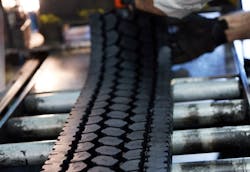Despite enjoying 44% of the U.S. retreaded truck tire market through its Bandag brand, Bridgestone Americas Inc. is not resting on its laurels. In this MTD exclusive, Jason Roanhouse, executive director, Bandag operations, Bridgestone Commercial Solutions, discusses how Bandag pulled through COVID-19, high-growth segments of the market, the evolving demands of retread customers and more.
“We’re constantly trying to evolve to help customers meet the objectives of the industries they serve and their customers,” says Roanhouse.
MTD: What was Bandag’s business like last year? What impact did COVID-19 have on Bandag’s growth?
Roanhouse: The impact on our dealer partners in 2020 led to a lot of changes in how our manufacturing dealers operated to support the transportation industry, meaning new safety protocols and processes. Not only our manufacturing partners — but also the Bandag support staff — had to very diligently look at how we made sure Bandag was able to service transportation industry customers.
The beginning of the year for us — and everyone else in the industry — was ‘ Will there be supply? Will there be casings? Will there be tread rubber?” And everything led to fleets making decisions around their tire programs and retreading programs, including buy-ups that were happening. This created a lot of unique circumstances and our dealers really had to ramp up to meet that demand.
Throughout the balance of the year, I would say business stabilized and it was pretty strong for us, but maybe in different ways than it had been historically. If you look at how the transportation industry was impacted by the pandemic, we saw the influx of last-mile delivery and we saw smaller tires become more prevalent. We saw changes in the refuse haul industry for retreading. Our dealers had to get really creative in securing casings from sources.
Dealers across the retread business did a fantastic job of adapting to a lot of uncertainty. Given all the challenges, I would say business has been strong for us. And we continued to make progress in our overall operations.
MTD: One thing we noticed during the early months of COVID-19 is that demand for truck tires and retreads remained relatively healthy, while demand in some other product segments plummeted.
Roanhouse: We saw a lot of fleets in March 2020 that were concerned about the availability of products. This uncertainty drove additional purchases early. Then we saw a brief valley and then a lot of stability and even growth through the balance of the year.
As everyone adapted to that new normal, we actually saw increases in certain segments of the business, from a retread perspective. More e-commerce, more last-mile fleets — more of our partners in that space grew considerably and we supported them.
MTD: Are there certain segments, like last-mile, where retreaders are realizing, ‘There’s some opportunity here that might not have existed even five years ago?’ I’m also thinking of short-haul and regional haul operations.
Roanhouse: We did start to see traditional fleet customers further tailor their operations to that last-mile or urban delivery market. We’re seeing customers that only ran Class 6, 7 and 8 trucks that are acquiring and operating more vehicles in smaller classes to serve their customers. And that’s kind of shaping their business and shaping how we look at their tire programs.
In addition, with the increase in e-commerce and home deliveries, we continue to look at last-mile delivery and new ways and processes to service that segment.
I think the traditional lines of commercial tire sizes and consumer tire sizes over the past few years have become more blurred and we need to take a more holistic approach to how the customer buys and what their tire program needs are, including retreading. We’re looking at new processes, new technologies and new manufacturing operations that will allow us to offer customers new selections in those smaller-tire spaces.
MTD: Are you at liberty to discuss any of those new processes or technologies?
Roanhouse: I’d say we’re more in the preparatory storage. Our current Bandag process can address tires down to 16 inches in diameter. But there are new technologies emerging that will allow us to serve that space more efficiently.
MTD: It appears that tariffs on new medium truck tires that are manufactured in China did not necessarily lead to an explosion in demand for retreads in the U.S. market. Those tariffs have been extended. Do you think this will have an impact on retread demand over the next 12 months?
Roanhouse: Although we watch tariffs pretty closely and we’ve seen what happened, we’ve focused our energies around Bandag and improving our process. The retread value proposition for our customers is already really strong. So while tariffs are in place and they may have an influence on customers’ buying decisions, we’ve chosen to focus our attention more on the areas we can control. I don’t think we can count on tariffs too much.
MTD: Bandag rounded out its MaxTread family in 2020. Can you bring us up to speed on that line and where it fits within your overall product portfolio?
Roanhouse: The concept behind MaxTread is to offer customers another choice at the point of purchase. Maybe there’s a customer looking to buy a new tire at a certain price point. We want to offer them a reliable alternative and we wanted to brand it in a way that was specific to their needs — demonstrating that it’s a high-quality casing, inspected in the Bandag process, sold as a single unit, with all of the warranty and support you’d get with a Bandag retread versus having to open the discussion with cap and casing.
MaxTread was designed to meet the needs of a growing segment of the market that is purchasing tires from their local tire dealers and looking for the quality of a new tire and the economic savings of a retread.
We feel like the MaxTread line, as part of the Bandag brand, offers a holistic solution for that customer. And we hope those customers continue to grow and expand their operations, so we can move them into a more traditional tire program, where they are purchasing a new tire, maintenance and consultative services.
MTD: Bridgestone has divested a number of GCR locations over the past few years. For example, Pomp’s Tire Service Inc. purchased 19 GCR locations in 2020. McCarthy Tire Service Co. Inc. purchased 13 GCR locations, plus three GCR retread plants, in 2019. But there are remaining Bridgestone-owned GCR locations. Can you bring us up to speed on the role those locations will continue to play in Bridgestone’s retreading strategy?
Roanhouse: From a retread perspective, I will say that GCR is at the core of our dealer operations. GCR allows us to test new solutions, products and systems and it’s also extremely important to our overall distribution network. The GCR locations you see on the map play a strategic role in helping serve our customers throughout the U.S. and Canada. The GCR organization is extremely well-aligned with our strong independent dealer network.
MTD: What’s your take on the current state of truck tire and retread demand?
Roanhouse: The first quarter was as strong as - maybe even stronger than - what we expected. Our Bandag production has been stable and strong. Still being in a pandemic situation, I would say our dealers have done an exceptional job of managing their operations.
We’re bullish on 2021 as we continue to work through the pandemic and how we’ve positioned ourselves. We have new equipment coming online. We have a new builder that Bandag has designed. It’s a tread-matching builder, with a smaller footprint and greater efficiency. There are equipment and innovation advancements. Our team has done a tremendous job of maintaining momentum in this environment.
MTD: The traditional truck tire retread value proposition has been, from the customer’s perspective, quality and performance that are comparable to a new truck tire, but at a more affordable price, which makes retreads an attractive proposition for more budget-conscious fleets. Do you find that traditional retread customers have become more sophisticated in terms of their product performance expectations?
Roanhouse: I think customer expectations, rightfully so, always increase. Our responsibility is to make sure we are keeping pace with their increasing levels of sophistication. The basic core message of value is still there. And it’s not even price point. It’s the overall economic value of running a tire program effectively. Customers have become significantly more advanced in that regard. They are using more technology. They’re seeing tire inflation monitoring. They’re seeing faster response times with our dispatch and fleet management platforms. We are constantly trying to evolve to help customers meet the objectives of the industries they serve and their customers. And that includes maximizing retreading.
I also want to mention the fact that our customers are becoming far more sophisticated from an environmental perspective. Retreading has always been an incredibly environmentally friendly process, even before a lot of attention was paid to sustainability. ‘How much waste do I keep out of landfills? How much petroleum do I save? How does retreading translate into energy savings?’ We’re shifting our message to deliver a broader message to the industry.
About the Author
Mike Manges
Editor
Mike Manges is Modern Tire Dealer’s editor. A 28-year tire industry veteran, he is a three-time International Automotive Media Association Award winner, holds a Gold Award from the Association of Automotive Publication Editors and was named a finalist for the prestigious Jesse H. Neal Award, the Pulitzer Prize of business-to-business media, in 2024. He also was named Endeavor Business Media's Editor of the Year in 2024. Mike has traveled the world in pursuit of stories that will help independent tire dealers move their businesses forward. Before rejoining MTD in 2019, he held corporate communications positions at two Fortune 500 companies and served as MTD’s senior editor from 2000 to 2010.

